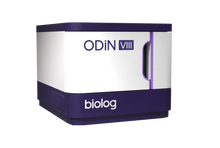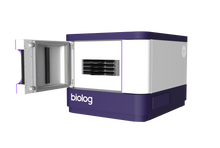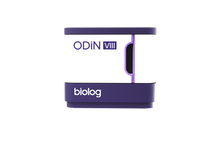For rapid automated incubation and identification of aerobic and anaerobic bacteria, yeast, and filamentous fungi. The Odin VIII™ System offers the same powerful capabilities as the Odin L™ System but with a more compact 8-plate capacity. This instrument is also known as the all-in-one solution for cellular metabolic characterization and growth kinetics, in addition to ID. It's powered by Odin™ software, allowing for convenient exporting, saving, and printing of data.
This system includes a computer with one software license and all Biolog identification databases, turbidimeter with a set of turbidity standards, installation, training and a one year warranty. Pipettor and printer are sold separately.
It can be configured for ID or phenotypic analysis only or have both capabilities in the same instrument - you can decide which option is best for you.
The new Odin VIII™ System is a smaller scale version of the Odin L™ System. Manage up to 8 plates with ease—perfect for focused experiments, streamlined workflows, and efficient operator collaboration. Odin™ instruments are the all-in-one solution for cellular metabolic characterization, growth kinetics, and identification.
For nearly 40 years, Biolog technology has been critical for microbial identification for many companies. A proprietary set of reagents are pre-arrayed on microplates, and respiration is monitored over time with a reporter dye. At every interval, Odin searches its extensive database of nearly 3,000 organisms to match the unique respiration fingerprint, designed to meet the needs of a wide range of customers across various disciplines of microbiology. Identify aerobic Gram-negative and Gram-positive bacteria, anaerobes, yeast or filamentous fungi in the same test panel with a single instrument. Gram stain and other pre-tests are no longer needed. A simple one-minute setup protocol and your samples are ready to be analyzed.
You can also efficiently phenotype your microbes by screening hundreds or even thousands of different substrates and growth conditions in a controlled environment. Phenotype MicroArrays (PMs) represent the third major technology, alongside DNA Microarrays and Proteomic Technologies, that is needed in the genomic era of research and drug development. Just as DNA Microarrays and Proteomic Technologies have made it possible to assay the level of thousands of genes or proteins all at once, Phenotype MicroArrays make it possible to quantitatively measure thousands of cellular phenotypes all at once.

Profiling metabolic phenotypes is important in determining how efficiently an organism can work.
Odin automatically compares cell growth and metabolic activity curves to provide you with a clearer picture of how fast or slow your microbes are growing.
It measures a reporter dye at one wavelength to measure NADH production, effectively reporting the rate of metabolic respiration and also measures optical density (OD) at a second wavelength to determine how quickly the microbes are dividing. Taken together, you get a full picture of how your microbes grow best. However, the dye could be left out if you're specifically focused on cell growth.
Determine the best media to produce a drug product or find the best nitrogen-fixing bacterial strain, track production across passages, understand the metabolic impact of gene edits and a whole host of other applications. A microbe may grow better at different temperatures or with different feed sources—to understand it all is a mind-boggling exercise!
With Odin, you can efficiently distinguish between cellular phenotypes under a variety of parameters. In conjunction with Biolog’s Phenotype MicroArrays, microbes are grown under a wide range of conditions, with data automatically captured to reflect growth and respiration of every well of the plate. You can literally screen thousands of conditions at the same time.
If you initially purchase the instrument configurated for ID only, you can later on add the phenotypic characterization capabilities to an existing Odin system - or vice versa. (You also have the option of acquiring it from the start with both capabilities). This offers you the flexibility to expand and enhance the capabilities of this powerful equipment at any time.
Product Literature: Odin Family Brochure, Odin Phenotype MicroArray™ technology, Microbial ID Databases
Visit Biolog's website for more information: Odin Family Instruments, Identification Databases
Another alternative is the semi-automatic system which is a single plate reader: ID Station. However, if you prefer a bigger scale version of this system, check out the Odin L that has a 50-plates capacity.






